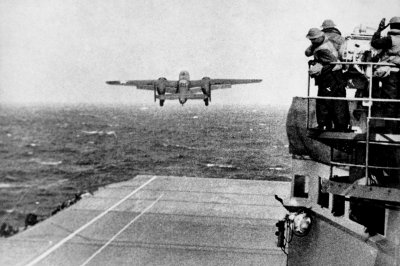Topic: James Doolittle
The Doolittle Raid, on 18 April 1942, was the first air raid by the United States to strike the Japanese Home Islands (Honshu) during World War II. It demonstrated that Japan itself was vulnerable to American air attack, and it exploited a vital psychological need and opportunity for U.S. retaliation after the Japanese attack on Pearl Harbor on 7 December 1941. The raid was planned and led by Lieutenant Colonel James "Jimmy" Doolittle. Doolittle would later recount in his autobiography that the raid was intended to bolster American morale and to cause the Japanese to begin doubting their leadership:
The Japanese people had been told they were invulnerable ... An attack on the Japanese homeland would cause confusion in the minds of the Japanese people and sow doubt about the reliability of their leaders. There was a second, and equally important, psychological reason for this attack ... Americans badly needed a morale boost.
Sixteen U.S. Army Air Forces B-25B Mitchell medium bombers were launched from the U.S. Navy's aircraft carrier USS Hornet deep in the Western Pacific Ocean. The plan called for them to bomb military targets in Japan, and to continue westward to land in China—landing a medium bomber on the Hornet was impossible. All of the aircraft involved in the bombing were lost and 11 crewmen were either killed or captured—with several of the captured men executed by the Japanese Army in China. One of the B-25s landed in the Soviet Union at Vladivostok, where it was confiscated and its crew interned for more than a year. Thirteen entire crews, and all but one crewman of a 14th, returned either to the United States or to American forces. The raid caused negligible material damage to Japan, but it succeeded in its goal of helping American morale, and casting doubt in Japan on the ability of the Japanese military leaders. It also caused Japan to withdraw its powerful aircraft carrier force from the Indian Ocean to defend their Home Islands, and the raid contributed to Admiral Isoroku Yamamoto's decision to attack Midway—an attack that turned into a decisive rout of the Imperial Japanese Navy (IJN) by the U.S. Navy near Midway Island in the Central Pacific.
It uses material from the Wikipedia article "James Doolittle."







